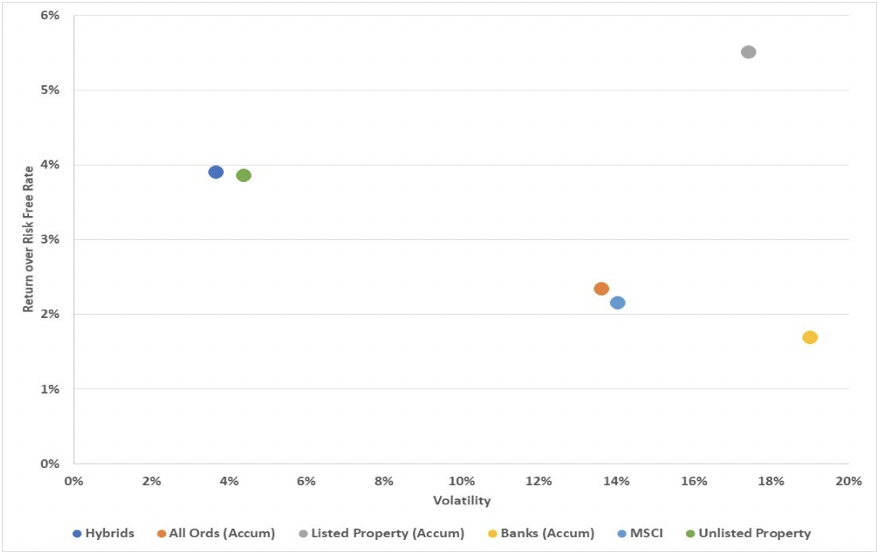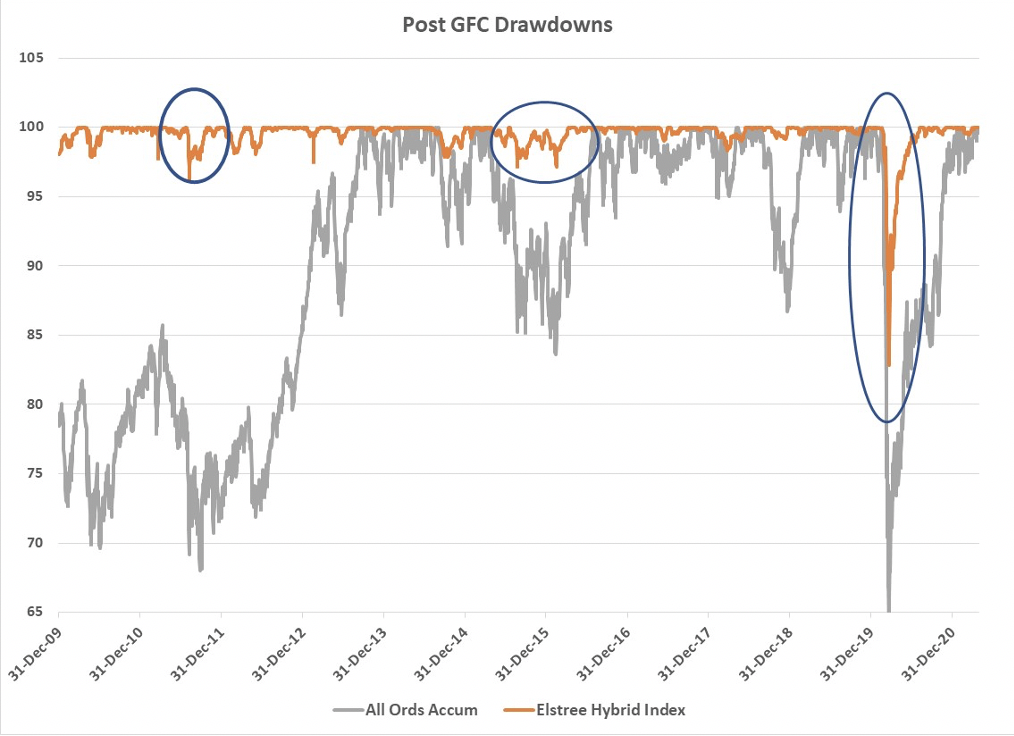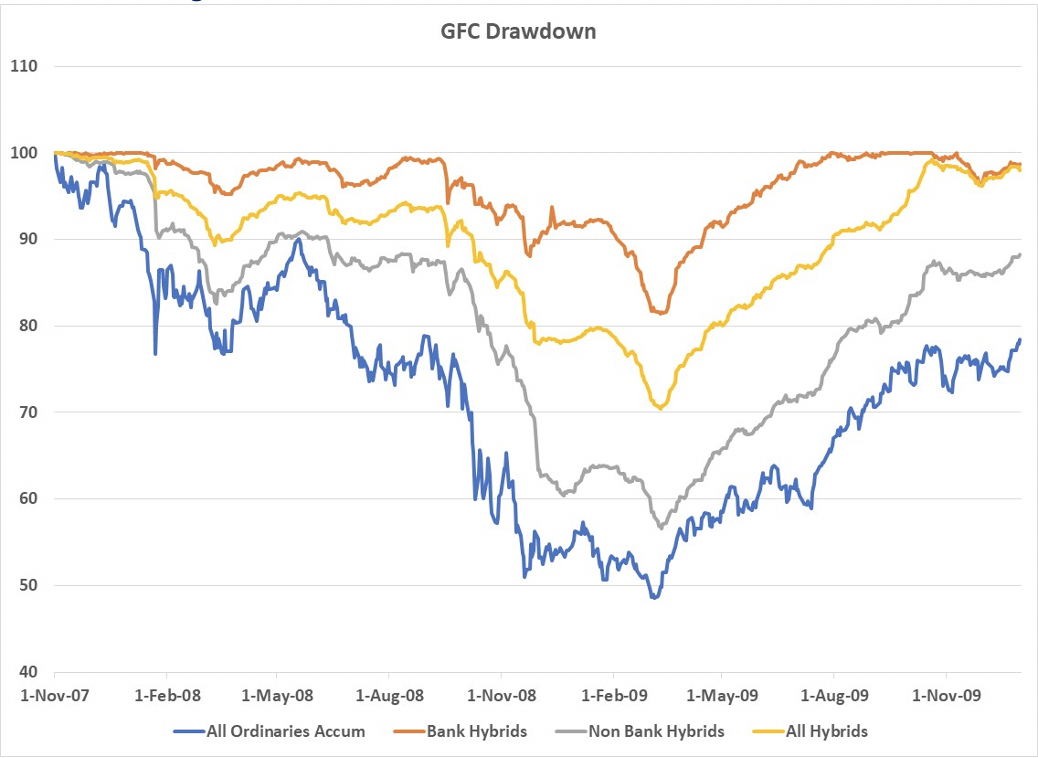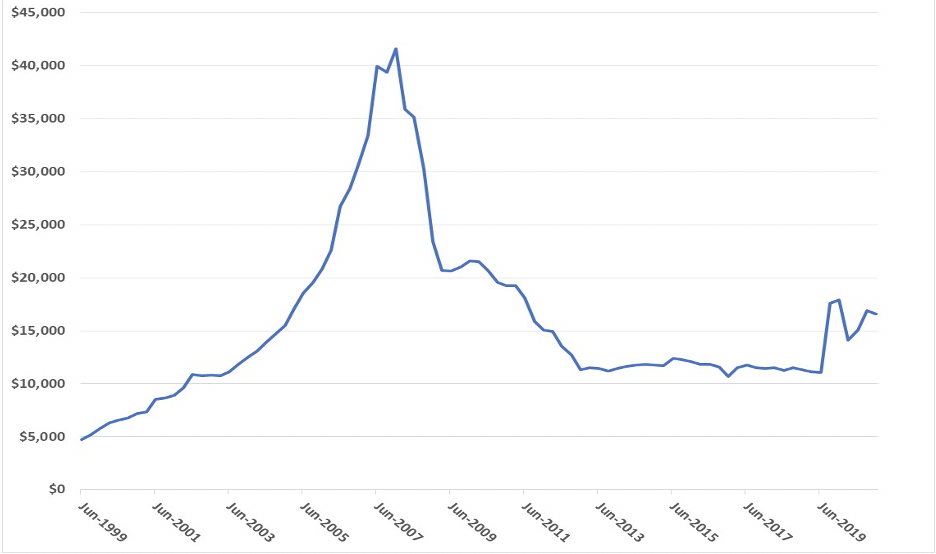How do hybrids perform under stress?
Over the last decade, hybrids have produced returns that have been comparable or better than most other asset classes, but for any investor that is only half the equation. There is always the question of risk. We use Elstree Hybrid index data to look at when and why hybrids weaken and detail previously undisclosed data to show why the GFC hybrid experience is highly unlikely to be repeated.
Equity returns, bond risk
The chart below shows returns over risk-free rates for a number of asset classes for the decade ending 31/12/2020. The best performing asset class was Listed Property, but with considerable volatility. Hybrids and Unlisted Property both produced the best risk-adjusted returns (probably because property is only valued once a year and there is no market; you never see the volatility).
The more interesting aspect was that equities only returned 2% more than bond rates with volatility of 14%. Bank equities were even worse, with the popular sector barely beating bond returns.

Only occasionally weak and not for very long
One of the most attractive aspects of hybrids has been that weakness is short-lived and shallow. Hybrids were within 1% of index high levels over 85% of the last decade. The comparative figures for bonds and equities are 79% and 26%.
There have only been 3 periods in the post GFC era where hybrids have demonstrated any weakness. Two were shallow and of short duration and the other was Covid19 which was deeper, but still short-lived. The chart below shows the drawdown profile of the Elstree Hybrid index and the All Ordinaries since the GFC (an index of 100 shows the index at all-time highs while an index below 100 represents the amount below all-time highs), with the weakest periods highlighted.

COVID-19 doesn’t need much explanation; it’s pretty recent in people’s minds, and it was short brutish and nasty.
Equities fell by 35% at worst, hybrids had a drawdown of around 16%, but if you take out the worst 2 days, it was around 11%. Hybrids saw a maximum delta of around 30% i.e., hybrids had fallen by around 30% of the equity market fall, but over the life of crisis, it averaged around 20%. Hybrids had recovered by the end of August while it took equities until early 2021 to regain pre-Covid highs.
Last decade’s weaknesses were variations on the themes of busted Euro/Euro banks and recession risk.
In 2015, everybody got concerned about Chinese growth (which helped explain a big fall in oil prices) and US bond yields went up late in the year. Oh, and Greece defaulted on its debt in June 2015.
So, there were lots of things going wrong in the world and the All Ords was a slo-mo car crash and lost around 15% between April and October, recovered a bit over the next month and then encored with another 10% retreat in January.
Hybrids’ maximum drawdown of 2.7% was in August 2015, soon after a few days where the world equity markets fell by up to 10%. Hybrids took a bit longer to recover than usual, and they were then flat for a further 4 months until February 2016, but then produced stellar returns from March 2016.
That one hurt
2015 was like going 12 rounds with Mike Tyson; not so much from the
severity, where hybrids lost a few months income (compared to equities that lost
around 4 years of dividend return). It was more so from the length of the
hybrid drawdown, which meant investors had lost confidence after 6 months of
not much return.
We can still recall the
CBA trying to issue a hybrid at the highest ever issue margin of 5.2% in
February and seeing limited market demand, because lots of investors were
confidence-ed out. CBA was bailed out when Unisuper was a late investor taking a few hundred $m of the issue and CBA ended up with the $1.4b issue they wanted.
Hybrids fell 3.8% in August 2011 but recovered within 6 weeks.
As with most other instances of hybrid softness, there had been an extended period of equity market weakness. Equities weakened by 10% between April and August and a further 10% between August and October. Recessions, European banking systems and problems in Europe were again negative influences.
There were 2 hybrid-specific influences. ANZ announced a new hybrid (ANZPC). This was the first of the Basel 3 compliant hybrids which contained the “non-viability” clause that allowed APRA to convert hybrids to equity. There was lots of negative commentary about that and how Basle 3 hybrid valuations compared to bank equity. At the same time, margins weren’t obviously cheap, with margins falling below 2.5% in June.
So, there were not unreasonable catalysts for a fall, but it was shallow and relatively short-lived.
GFC: still causing nightmares
One of the major fears of hybrid investors we speak to is a repeat of the GFC. These fears are largely unfounded. The Elstree Hybrid index is the only comprehensive record of pre 2012 market returns and the previously unpublished data below shows that for bank hybrids the GFC was not that unusual.
The chart below shows drawdowns for Elstree Hybrid index and the bank/insurer and non-bank subcategories. As can be seen, bank hybrids didn’t perform too badly, having a maximum drawdown of almost 20% compared to an equity market that fell over 50%. They recovered within 5 months. Non-bank hybrids were much more badly affected, but most of the losses were due to a large number of sub-investment grade issues.

Hard to see history even rhyming, let alone repeating
There were 3 important factors in the pre GFC market that made the experience worse, and which no longer exist in the post GFC hybrid landscape.
- Margins were much lower. Margins on bank hybrids moved from 1% in 2007 to c5% in early 2009. This resulted in capital losses of c15%, which is the bulk of the bank hybrid drawdown. Post GFC, hybrid stress events have also seen margins top out around 5%, but the starting level of c3% results in capital losses of c7%. For bank hybrids to reproduce a GFC type capital loss, margins would have to increase to around 7% (which we have never seen)
- The hybrid market was structured differently. Bank/Insurer hybrids comprised around 50% of the index. Of the 50% non-bank hybrids, around half was non-investment grade issuers with the balance having low investment-grade credit ratings. Both these non-corporate categories are going to be far more volatile in times of stress. Currently, around 98% of the index is investment-grade issuers and 90% by banks/insurers which, in general, have strong investment-grade ratings. The path of investment-grade hybrids in 2008 was not significantly different to that seen in post-GFC stress events.
- There was an enormous margin lending unwind. The chart below shows the path of margin lending this century

There was enormous growth of margin lending in the run-up to the GFC and an even quicker unwind. Hybrids were an easy source of liquidity to meet margin calls (compared to small and mid-cap equities) and much of the selling of hybrids can be attributed to that. With margin lending no longer being a material part of market architecture, there is less likely to be loose selling.

1 topic
1 contributor mentioned
